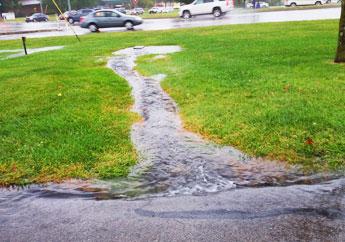
Nonpoint source pollution is any pollution that generally cannot be traced back to a single source or point (e.g. a pipe). Nonpoint sources can include:
- Storm sewers, ineffective septic systems and underground storage tanks
- Construction sites, mining areas, crop fields, pastures and confined animal feeding operations
- Paved surfaces, rooftops and lawns
Nonpoint source pollution occurs during and after rainfall, snowmelt and irrigation events. Water from the event either runs across the landscape or through the ground and picks up pollutants from those nonpoint sources. The water then transports the pollutants, such as bacteria, animal waste products, fertilizers, herbicides, pesticides, oil and grease, chemical contaminants and sediment, to our ponds, rivers, streams, lakes, wetlands or groundwater. When polluted water enters our surface waters and groundwater, the receiving water can become degraded.
Nonpoint source pollution is usually traced to multiple sources within a watershed, such as urban stormwater runoff, agricultural practices, construction activities or ineffective septic systems. Atmospheric deposition and hydrologic modification are also sources of nonpoint source pollution. In Missouri, significant sources of nonpoint source pollution includes agricultural land, urban areas and abandoned mines. All land use practices – whether urban, suburban, or rural – have the potential to impact water quality through nonpoint source pollution.
Nonpoint source pollution is the greatest threat to Missouri waters, contributing large amounts of bacteria, sediment, nitrate and phosphorus, chloride and other pollutants to the water. These pollutants can impair the receiving water's designated uses. Polluted runoff can negatively impact drinking water supplies, recreational uses, wildlife and aquatic habitat, and can cause excessive algal growth (harmful algal blooms) and odors, and devalue property. Over 85% of our impaired rivers and streams and over 50% of our impaired lakes are impaired by nonpoint source pollution.
Reducing Nonpoint Source Pollution
The good news is that nonpoint source pollution can be reduced by becoming aware of how land use can impact the quality of our waters – and by choosing land management practices with eliminating nonpoint source pollution in mind. The department takes two general approaches to managing nonpoint source pollution.
- Regulations: While most nonpoint sources of pollution are not formally regulated, there are some activities that require a permit from the department. Permits are issued to control stormwater runoff from land disturbance activities of an acre or more, as well as for certain industries like biodiesel manufacturers, agrichemical producers and Concentrated Animal Feeding Operations (CAFOs). Other activities requiring a permit include clay, rock and mineral mining, abandoned mine land reclamation, land application of human and animal wastewater and underground petroleum storage. Construction, placement, dredging and filling, or general earth moving within a wetland or waterbody requires a 401 certification from the department and 404 permit from the U.S. Army Corps of Engineers. Single family septic systems, which can be nonpoint sources of pollution, fall under the jurisdiction and responsibility of the Missouri Department of Health and Senior Services.
- Voluntary Actions: This approach relies on voluntary action through programs that offer monetary incentives and grants. Using land management practices that reduce and slow runoff greatly reduces nonpoint source pollution.

